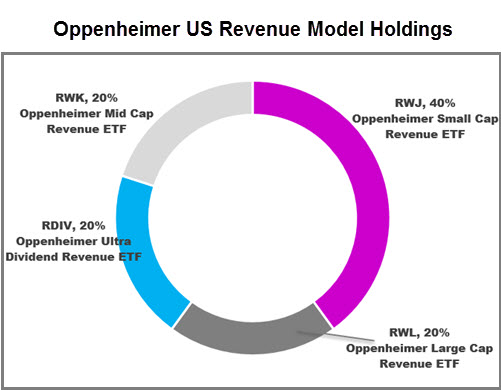
We are excited to announce the launch of our newest ETF Model, the Oppenheimer US Revenue Model.
- Join us for the Nasdaq Disruptive & Thematic Investing Symposium on Monday April 23rd from 12:00 - 4:00pm. The topics covered include: Blockchain Technology, disruptive income producing strategies, portfolio construction utilizing thematic components, and disruptive technology and where it fits into your investment strategy. This will be accepted for 4 CFP/IMCA/CFA CE Credits too. For more information click here. To register for the event, click here.
- We are less than three weeks out from our Spring 2018 Point & Figure Institute! Be sure to reserve your spot for the DWA Spring 2018 Point & Figure Institute in Las Vegas on May 3rd & 4th. Click here for more information or to register.
We are excited to announce the launch of our newest ETF Model, the Oppenheimer US Revenue Model. The Oppenheimer Report will be updated on Thursday mornings, prior to market open, and will provide you with commentary on Oppenheimer exchange traded funds, as well as the current Oppenheimer US Revenue Model Portfolio. To access the report, simply put your mouse over the "Research" tab and click on "Oppenheimer ETF Report". Click here for the Oppenheimer US Revenue Model Portfolio factsheet.
Why an Oppenheimer US Revenue Model?
- "Play the Piano with Both Hands" - Remember that old adage we like to use often? The Oppenheimer US Revenue Model allows you "play the piano with both hands," as the model incorporates both fundamentals, through the Oppenheimer Revenue Weighting Methodology, and a top-down Dorsey Wright Technical overlay. This way, you are able to play better music by combining the fundamentals with the technicals.
- Combining Value & Momentum - At Dorsey Wright, we believe momentum can be used as a stand-alone investment strategy; however, combining it with other smart beta factors, to which momentum is negatively correlated, such as value, has its advantages. We have referenced this in previous research pieces and blog posts, noting that it allows for a portfolio to capture alpha at different periods of the market cycle, which in turn can reduce both drawdowns and volatility.
- Complements Traditional Core Size & Style Solutions - Over the years we have seen the demand for core equity solutions increase, and we believe that this Model can help support core equity exposure by providing a momentum tilt to value oriented exposure across large, mid, and small cap US equities.
Oppenheimer US Revenue Model Overview
The Oppenheimer US Revenue Model seeks to provide overweight exposure to the strongest fund within Oppenheimer's inventory of four revenue ETFs, which each provide broad exposure to one of the three size categories, as well as a dividend focused inventory, but do so with a weighting scheme based on top line revenue rather than market capitalization. For example, the Oppenheimer Large Cap Revenue ETF RWL provides broad exposure to the S&P 500 universe, but does so by providing greater exposure to lower valuation companies than does the cap-weighted benchmark.
The Model’s inventory consists of the following Funds:
- The Oppenheimer Large Cap Revenue ETF RWL
- The Oppenheimer Mid Cap Revenue ETF RWK
- The Oppenheimer Small Cap Revenue ETF RWJ
- The Oppenheimer Ultra Dividend Revenue ETF RDIV
Systematic Model Rules
- The Model is evaluated on a monthly basis and remains 100% invested at all times
- The members of the four fund inventory are compared to one another using a Relative Strength Matrix
- The Model inventory is ranked from strongest to weakest based on each fund’s “buy rank.”
- The top position is overweighted at 40%, and the remaining three members of the Model’s inventory are weighted at 20% each.
- Upon the monthly evaluation, if the top ranked fund has fallen below the top two positions in the Matrix, that fund loses its overweight allocation, and the highest ranked ETF in the Matrix is then overweighted at 40%
- Upon each change, the model is rebalanced.
Current Model Holdings and Suggested Weights

